Interim Executive Dining Facility Bridges Construction Gap at Business School
Bridging the gap during construction and providing the same high-quality dining services to its prominent clientele took Harvard beyond the obvious solutions. In any such situation, the alternatives include off-the-shelf, temporary trailers, which, in this case, lacked a quality finished look consistent with Harvard's prestigious image, or a conventional building, which would have required a significantly longer build out. After much deliberation, Harvard Business School, or the B School, as its commonly known, opted to go with an architectural membrane structure and high-tech modular kitchen structures whose refined finishes and exterior appearance fit the university's objectives. The interim executive education dining and kitchen facility has been operating since March 2014 while the new facility is being built, and has met key aesthetic considerations as well as strict budgets and timelines—a solution that was not previously available on such a high level.
The Importance of Color
A key factor in Harvard's decision to go with a membrane structure was color—specifically, the fact that the membrane exterior could be color matched to the exterior of the existing architecture at Harvard. The university took advantage of a new development—a Kynar®-coated1 membrane, the only such product currently available that provides a proven color-fast solution that will not fade. Previously available on metal coatings, within the past few years Kynar has become available as a coating on membrane. Kynar is a polyvinylidene fluoride (PVDF) resin2 used in the makeup of fluoropolymer resin-based coatings. Fluoropolymer resin-based coatings take advantage of the inherent strength of the carbon-fluorine bond, one of the strongest known to science.
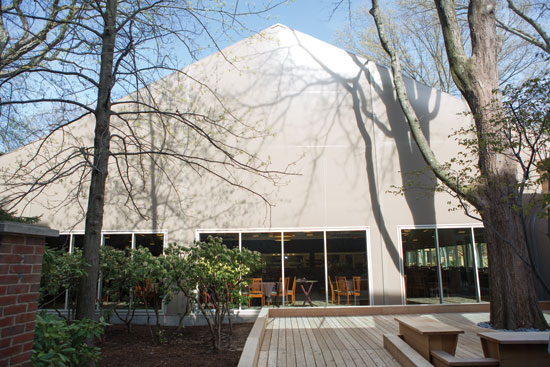
Photo courtesy of Kitchens To Go/Sprung Structures
A key factor in Harvard’s decision to go with a membrane structure was color—specifically, the fact that the membrane exterior could be color matched to the exterior of the existing architecture at Harvard.
A Tensioned Membrane Structure with High-End Finishes
Architecturally, the interim facility is a tensioned membrane structure that is made up of a series of aluminum frames covered with a polyvinyl chloride (PVC) membrane stretched between them. The structure itself, which utilizes a number of 5-foot 10-inch aluminum I-beams to span the 80-foot width, is set up to be a permanent facility (though relocatable in design) and will be on site for up to 32 months. Full HVAC facilities are incorporated to keep occupants cool in summer and warm during the winter months—this works very efficiently thanks to the 8-inch-thick (r25) blanket of fiberglass insulation within the walls of the structure.
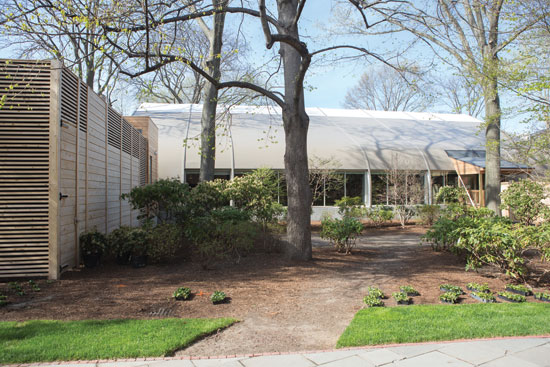
Photo courtesy of Kitchens To Go/Sprung Structures
The structure is set up to be a permanent facility (though relocatable in design) and will be on site for up to 32 months.
The university brought in a noted design team, Shepley Bulfinch, to work specifically on the interior of the dining and servery area. Designers specified high-end finishes and solved multiple space issues. “The volume was the piece we focused on the most,” says Sara DiNoto, associate at Shepley Bulfinch. One challenge was fitting the required number of seats and the servery within the length and width of the structure, and creating viable transitions between the seating area and the servery. “We looked at a few ways of how we were going to anchor the space with the servery,” says DiNoto, explaining that ultimately a few partitions were built to create an endpoint and serve as a “storefront” for that piece of the structure.
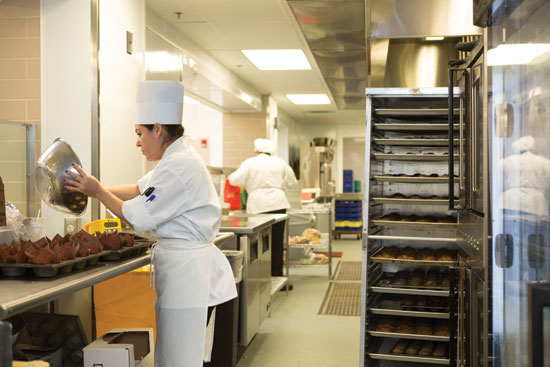
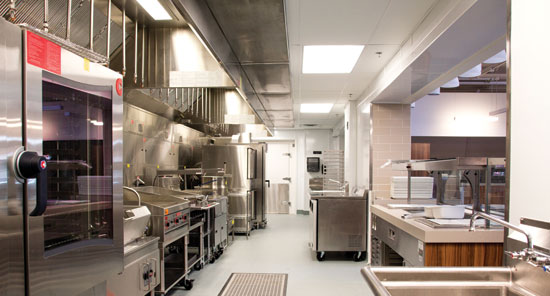
Photos courtesy of Kitchens To Go/Sprung Structures
The interim kitchen facility at Harvard Business School is an aesthetically pleasing structure with code-compliant, food service grade finishes.
Another issue was the high ceiling which afforded considerable volume above the usable portion of the building. To deal with that extensive space, the design team utilized acoustical ceiling clouds with ceiling fixtures and dropped pendants. At the center, however, an open ceiling system with larger drum pendants was employed both to allow light from the daylight panels to shine through and to adjust the scale of the building.
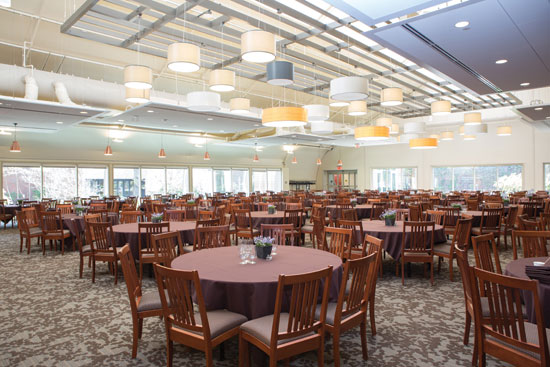
Photo courtesy of Kitchens To Go/Sprung Structures
Interim kitchen and dining facilities are a high-quality, cost-effective solution when renovating permanent structures.
The foodservice production facilities include cooking modules, prep modules, and cold and dry storage facilities as well as a 24-hour in-house bakery, all of which function to serve breakfast, lunch, and dinner. Breakfast is cooked entirely in house, and for lunch and dinner, some of the foods are brought in already prepared, such as the soup offerings. Other foods are finished and cooked in the facility, so the preparation and cooking area is used as a finishing kitchen and also as a full-function bakery, with all areas consolidated into an effective workflow.









